Distinguished Critique: Batman: Tales of the Demon Review
This volume, though somewhat oddly structured, offers a nice cross-section detailing the original conflict between Batman and Ra's al Ghul
—by Nathan on August 8, 2024—
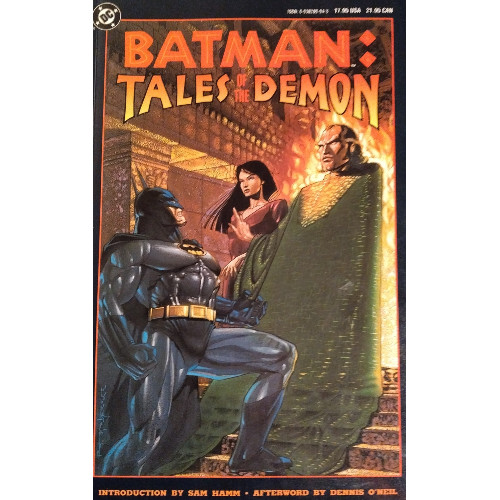
I find myself oscillating between the pre-Crisis and post-Crisis DC Universes, blown where the winds of interest take me. I dipped my toe into the Batman side of pre-Crisis storytelling when reviewing DC's second-ever limited series, The Untold Legend of the Batman, courtesy of Len Wein, Jim Aparo, and John Byrne. I swung in the opposite direction just yesterday, examining Mike Barr and Dennis O'Neil's unofficial triumvirate of graphic novels collectively known as "The Demon Trilogy." The three narratives focused on Batman clashing with one of most famous foes, the eco-terrorist Ra's al Ghul. Back when I first read through the trilogy, about a year and change ago, I became curious about the Demon's Head's first appearances. A Dennis O'Neil creation, Ra's al Ghul represented a different class of criminal than the thugs and evildoers Batman regularly faced; I wanted to see how those original tales treated al Ghul's debut.
So we wing our way back into the 70s, farther than we've ever flown before in this series, to uncover those fabled first fracases between the Dark Knight and his long-lived enemy.
Batman: Tales of the Demon
Writer: Dennis O’Neil
Pencilers: Neal Adams, Irv Norvick, Michael Golden, Don Newton
Inkers: Dick Giordano, Dan Adkins
Colorists: Tom Ziuko, Rick Taylor, Cory Adams, Bob Brown, Adrienne Roy
Letterers: John Costanza, Milt Snapinn, Ben Oda
Issues: Batman #232, Batman #235, Batman #240, Batman #242-244, DC Special #15, Detective Comics #411, Detective Comics #485, Detective Comics #489-490
Publication Dates: May 1971, June 1971, September 1971, March 1972, June 1972, August 1972, September 1972, June 1978, September 1979, April 1980, May 1980
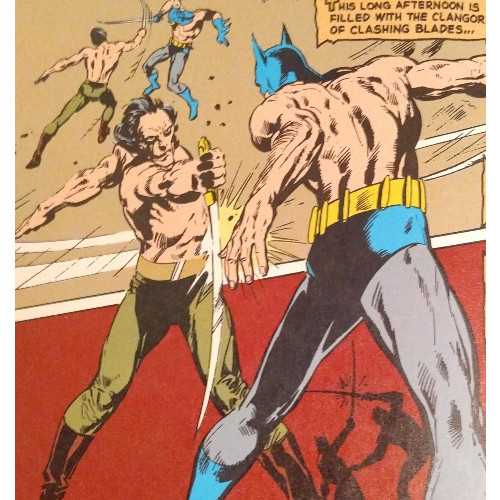
A while back, I reviewed a slim trade collecting part of O'Neil's run on Daredevil, an odd assortment of issues which failed to represent the entirety of O'Neil's contributions. The volume ends up a rather slapdash effort (I assume) to compile some narratives immediately preceding Frank Miller's "Born Again" arc. As a result, the volume ambles, carelessly, between plot points, and the chopped off issues are sorely missed.
So when I noted this Tales of the Demon volume performed a similar trick, collecting a seeming hodgepodge of issues across two different titles, I was slightly chilled. I knew this volume had one advantage, a character running through it in the guise of our primary antagonist Ra's al Ghul, but I wondered how thoroughly his story would be explored.
I am ultimately left divided.
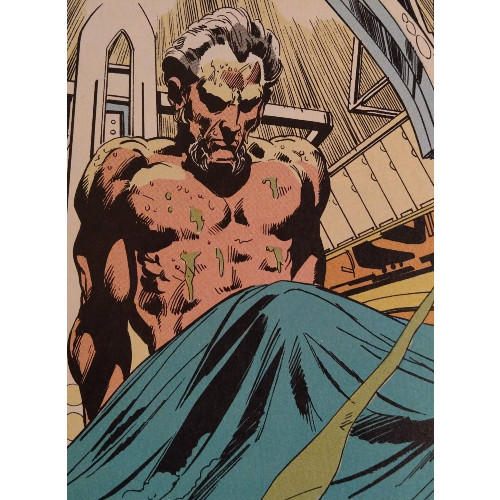
If you're looking for a snapshot of Ra's al Ghul's conflict with Batman before the "Demon Trilogy," this is a book to pick up. Key narratives–al Ghul's first appearance, the famous sword fight with Batman in the desert, his plot to marry Batman off to his daughter Talia–all appear here, integral moments in the developing conflict between himself and the Dark Knight Detective. O'Neil states in an introduction that, with al Ghul, he strove to create a villain absolutely different from any adversary Batman had faced until this point, and his efforts succeed. Ra's is dynamically dissimilar to other members of Batman's rogues gallery, not least because of his overarching goal: obliterating mankind to restore the Earth to its former glory. The Demon's Head is not all crazy cackles and gimmicky plots; he doesn't sport a crazy outfit or go by a goofy moniker or feel thematic in any way. He's unique, and O'Neil and his assembled artists define his uniqueness here very well.
Ra's is not initially introduced as an antagonist, nor is he overly combative with Batman for his first few appearances. He's more canny, willing to let others do his dirty work for him, and sees himself as an intellectual rival to Batman. Theirs is a game of wits, and one would be apt to compare their relationship to that of Sherlock Holmes and Moriarty. Except Ra's is a criminal in methodology only, fully driven by a goal that he believes is for the betterment of humanity even if it means sacrificing untold millions. I've always appreciated villains who view themselves in terms of heroism–Thanos, Lex Luthor, Magneto–and even though they would rarely win a philosophical battle against our hero, you still don't view them as out-and-out bad guys. There exists a bizarre nobility laced throughout Ra's personality even as he behaves deplorably.
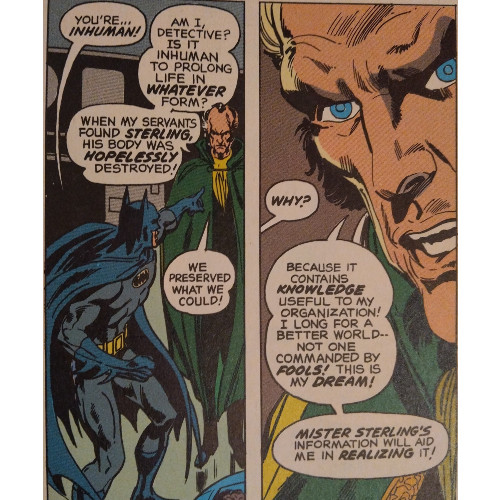
Where the tearing in me comes from is, similar to the Daredevil volume, how the narratives are presented. Several of these tales are one-shots, with Ra's serving as an overarching threat in most of them (his presence is lessened in the volume's latter half). We get him in pieces as O'Neil drip feeds us Ra's presence. There is development, no doubt. What begins as a hastily formed, shaky alliance between both men sours quickly, becoming increasingly antagonistic while toeing that line of mutual respect. You know that Ra's holds considerable admiration towards the Detective–dude officiates the wedding of his daughter to the Dark Knight in one issue!–and you sense Batman begrudgingly reciprocates (at least some of) the esteem. But they're each determined to not let the other gain the upper hand.
It's a rivalry not unlike Spider-Man and the Green Goblin's, which Stan Lee and Steve Ditko (with some help from the OG John Romita) initially presented across multiple issues. That conflict was developed piecemeal as well, but each chapter felt naturally confined to its individual narrative. O'Neil, from the start, indicates that Ra's is a genuine threat, a mover and shaker, introducing the dreaded concept of him in this volume's first issue before the Demon's Head ever physically appears. Yet presented in this fashion, with breaks between various issues, the villain's threat is minimized. Batman's first encounter with Ra's ends with Talia kissing the Dark Knight on the cheek, with the next installment skipping ahead a few issues and offering no resolution to that particular predicament. Ra's often escapes his adversary's clutches, occasionally because Batman lets him, once or twice because he seemingly dies. With "death" comes a resolution of sorts, but hindsight gifts us with knowing death is rarely permanent in this world.
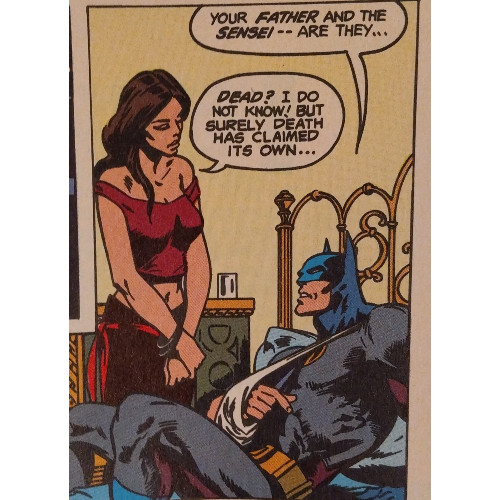
Do the issues "missing" from this volume go deeper into the Batman/Ra's rivalry? Does the Dark Knight Detective ever spend a few erstwhile panels considering his foe's fugitive status, become frustrated that Ra's constantly slips through his fingers, or wonder how he lets Talia al Ghul wrap him around her own finger on multiple occasions? I'm not sure. Maybe the other issues never addressed Batman's growing concerns with Ra's. But if they did, this volume is somewhat lessened by not including them. All the tension building in certain issues halts with the flip of a page, leaving me wishing we could bear witness to more resolutions.
O'Neil's best story pairs him with Green Arrow/Green Lantern contributor Neal Adams as the two scratch out a worldwide excursion as Batman faces Ra's in the snowy tundra of the Swiss Alps and the burning sands of the desert. This three-issue romp feels complete, a trilogy of titanic travels, narrow escapes, a genuinely interesting supporting cast, and a fully satisfying conclusion. O'Neil cleverly avoids a last-minute deus ex machina by employing strong character development from Talia al Ghul, who we watch throughout this volume struggle with her father's desires and her growing love for the Batman. As I noted in my Birth of the Demon review, Talia represents these two sides fairly well, and if in retrospect her continuing divided allegiance comes across as somewhat stale, it makes perfect sense here. As the volume continues, Talia does fall into the state of a puppy-dog-eyed woman hopelessly in love with a man whom she can never win, but it at least aligns with her character. She's not presented as a spoiled fool who demands her father bring her her beloved. She's cognizant enough to recognize she is, at times, a pawn and acts of her own will accordingly.
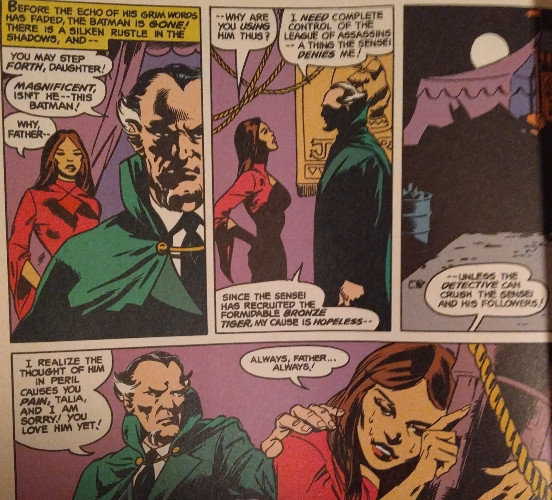
I was primarily impressed with how O'Neil handled our famous Caped Crusader. While Frank Miller is often principally associated with dragging Batman back into the darkness through his "Year One" and Dark Knight Returns narratives, many folks have pointed out Batman's transition from "goofy guy who battled aliens" to "brooding, hard-nosed vigilante who punched out killer clowns" began earlier, selecting these stories as evidence. Miller's take on Batman certainly involved a deeper psychological bearing than O'Neil's and later stories, such as Alan Moore and Brian Bolland's The Killing Joke and Mike Barr's "Batman: Year Two," would double down on the egregious violence (as well as, lest we forget, the whole "broken Bat" era during the 90s), so perhaps we can slot those into a different kind of darkness. O'Neil's take is certainly "serious" and so is his Batman, but our Caped Crusader is "serious" in the sense he's determined, almost obsessively so. This isn't Mike Barr having him callously watch a thug's face melt off or wield a gun against criminals because Batman is cool and guns are cool and so Batman + guns must = cool2.
O'Neil's Batman is a force, a living embodiment of justice crossed with high intelligence. He wears disguises, climbs mountains, braves the desert heat, pushes himself as far as he can to secure a victory even when victory feels unobtainable. He doesn't punch dudes in the face because "Argh! Violence!" He punches dudes in the face because they're bad dudes planning on hurting a whole buncha folks. Bruce is serious not because he broods in the shadows but because he possesses the determination necessary to sacrifice whatever he must to make certain as many people as possible are safe. And he's not unstoppable either–he fails to rescue one person, gets thrashed by bigger opponents, is rendered unconscious and taken prisoner. His vulnerability is a thread woven through this whole volume, more consistent than Ra's schemes and appearances and, I assume, emblematic of how O'Neil generally treated the character: grounded, human, assertive without coming off as gritty or cruel.
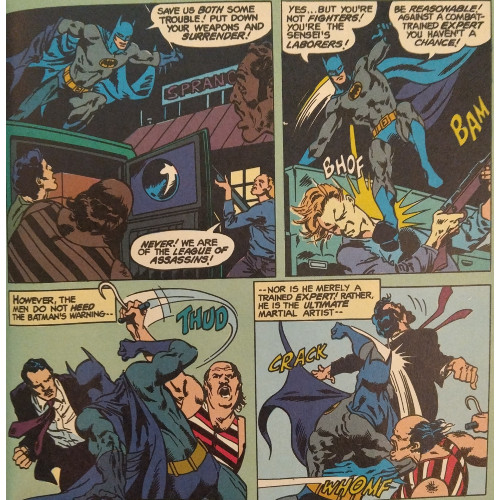
Tales of the Demon isn't a perfect volume, particularly as it feels a little jumbled in its presentation of material. O'Neil and his assembled artists create a terrifying villain in Ra's al Ghul, whose presence and legend occasionally outstrip his physical appearances. He's different, brilliant, his twisted morals clashing against a Batman determined to right whatever wrong Ra's seeks to wreak against humanity. This isn't necessarily a "saga" (and how even better this volume would be if it were!), but these stories establish a grand rivalry for all of you readers tired of all the Joker/Batman or Two-Face/Batman enmity. So take the stories as they come, generally a chapter at a time, save for a great three-parter that stirs up the imagination, making me wonder how fun a prolonged saga would play out between these famed adversaries.